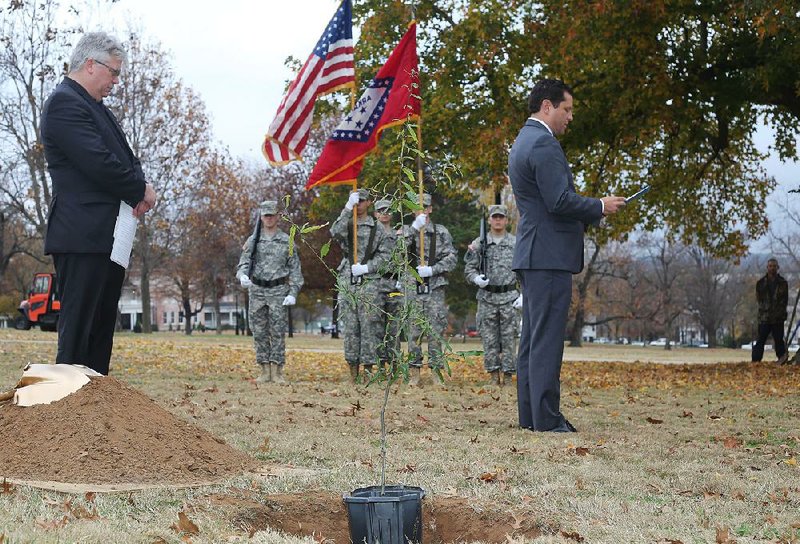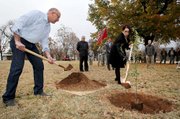Trees planted around the world a century ago served as living reminders of soldiers who died during World War I, part of a reforestation effort and a way to create distinct memorials.
During the centennial observance of "The Great War," memorial tree programs are again underway, with the goal in Arkansas to plant a specific commemorative willow oak in each of the state's 75 counties.
The state's program officially began in September and will continue through next year for the centennial observance of the United States' war involvement from April 6, 1917, to Nov. 11, 1918. Organizations in 47 counties, so far, have been approved to receive one of the memorial trees.
The commemorative tree program is a partnership of the Arkansas World War I Centennial Commemoration Committee and the Arkansas Forestry Commission.
The Centennial Committee manages the program and approves applications. The Arkansas Forestry Commission supplies the trees and lends its expertise in their care. More information is available online at wwiarkansas.com/wwi-memorial-trees.
With exactly 75 willow oaks designated for the state's commemorative tree program, it's important that remaining counties have groups to file their applications as soon as possible to the Centennial Committee, said Mark Christ, the Department of Arkansas Heritage's designated committee member and spokesman for the Arkansas Historic Preservation Program.
"It's definitely a first-come, first-served basis," Christ said. "We have had three or four cases already where a group has contacted us saying it they'd like a tree and we had to say, well, you already have one in that county.
"But, even if they don't get one [of the designated willow oaks], if a group plants a memorial tree, we'll put it on our website," he said.
The concept of planting trees as memorials to World War I veterans began in Europe, Christ said. The trees serve the dual purpose as memorials and as reforestation "because there were so many trees that had been destroyed."
The Forestry Commission is donating the 2-year-old willow oaks. The program not only connects with the commission's beginnings, State Forester Joe Fox said, but it is personal to him.
His father, W.S. Fox, served in France during World War I and was a member of the state's Forestry Commission for more than 40 years, including being its chairman from 1943 until his death in 1979, Fox said.
Many of the commission's volunteers after the commission officially began in 1933, he said, were World War I veterans.
"It's a very special thing for the Forestry Commission to participate in this," Fox said. "Our roots with the Forestry Commission go right back to World War I veterans."
The Centennial Committee also contributes to each planting by supplying a small amount of soil obtained from the Meuse-Argonne American Cemetery in France. The cemetery is on the site of the 47-day Meuse-Argonne Offensive, or the Battle of the Argonne Forest, that cost 26,277 U.S. lives and led to the deaths of about 28,000 German soldiers, the largest engagement of the war.
With each tree received, some of that French soil is to be added to the planting, Christ said.
The plan to incorporate some French soil was almost spoiled for the inaugural memorial tree planting Sept. 23 at the Old State House in Little Rock, which kicked off the program.
"We had to go through a number of bureaucratic processes," Christ recalled. The soil "literally showed up the day before the tree dedication at the Old State House. It arrived just in the nick of time.
"We had 3 pounds, and we're splitting it 75 ways," he said. "So some of the French battlefield will be here with the memorial trees here in Arkansas."
Memorial trees planted in Arkansas during the years after World War I have all but disappeared, Christ said. There is a grove of memorial American Holly trees on the Henderson State University campus in Arkadelphia. The Memorial Grove commemorates five students and a faculty member who died in World War I combat.
"It's the only known one in Arkansas left," Christ said. "And they rededicated it [Nov. 11]."
Several memorial tree plantings have taken place in several counties already this month, including in Washington County on the University of Arkansas, Fayetteville campus Nov. 17, near Old Main and Gearhart Hall.
Others have been planted this month in Ash Flat in Sharp County; Russellville in Pope County; Morrilton in Conway County; Malvern in Hot Spring County; Vilonia in Faulkner County; McCrory in Woodruff County; and Fort Smith in Sebastian County.
"I'm confident we'll hit every county before the end of next year," Christ said.
Northern red oaks were first considered for the memorial tree program, but the Forestry Commission had "a number of good-sized willow oaks that were a couple of years old," Christ said.
Fox said the willow oaks, a variety of the red oak family, are a good fit for the memorial program.
"Willow oaks have a life expectancy of more than 100 years," Fox said. "That's another reason to plant an oak tree."
Christ and Fox acknowledge that World War I often seems to get overlooked by the public, with more historic attention given to World War II, Vietnam and, especially in the South, the Civil War. A state commission spent five years commemorating that war's sesquicentennial that ended in 2015.
More than 71,000 Arkansans served in World War I, with 2,183 deaths, according to committee information.
"We talk about World War II vets quite a lot, and that's appropriate," Fox said. "We talk about Vietnam vets a lot, and that's appropriate. But we need to remember the vets from World War I just as much."
"World War II was such a huge event in the public's memory, it does kind of overshadow World War I," Christ said. "World War I was called The Great War because, at the end of the war, you couldn't conceive there being a World War II."
Metro on 11/26/2017

